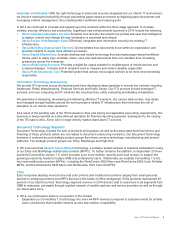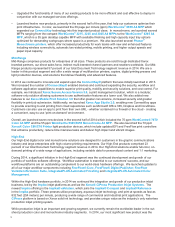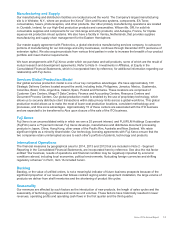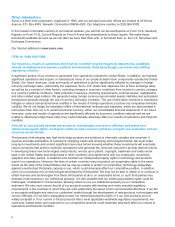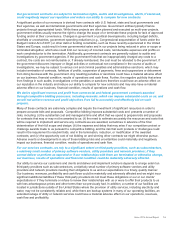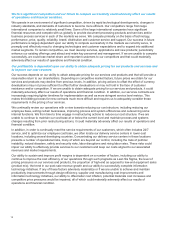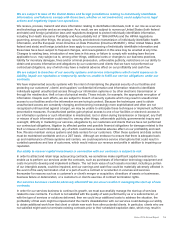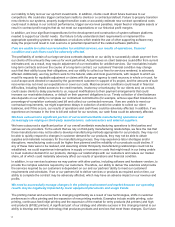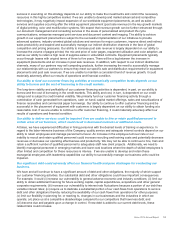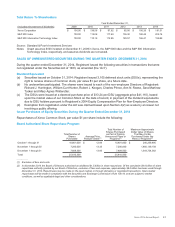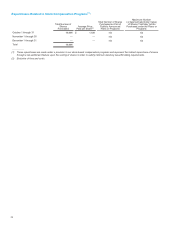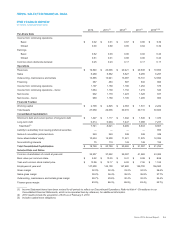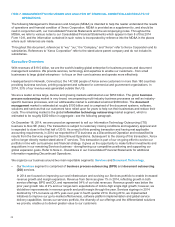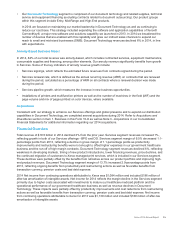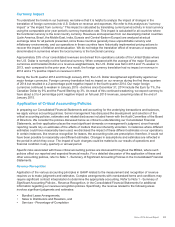Xerox 2014 Annual Report Download - page 33
Download and view the complete annual report
Please find page 33 of the 2014 Xerox annual report below. You can navigate through the pages in the report by either clicking on the pages listed below, or by using the keyword search tool below to find specific information within the annual report.success in executing on this strategy depends on our ability to make the investments and commit the necessary
resources in this highly competitive market. If we are unable to develop and market advanced and competitive
technologies, it may negatively impact expansion of our worldwide equipment placements, as well as sales of
services and supplies occurring after the initial equipment placement (post sale revenue) in the key growth markets
of digital printing, color and multifunction systems. We expect that revenue growth can be further enhanced through
our document management and consulting services in the areas of personalized and product life cycle
communications, enterprise managed print services and document content and imaging. The ability to achieve
growth in our equipment placements is subject to the successful implementation of our initiatives to provide
advanced systems, industry-oriented global solutions and services for major customers, improve direct and indirect
sales productivity and expand and successfully manage our indirect distribution channels in the face of global
competition and pricing pressures. Our ability to increase post sale revenue is largely dependent on our ability to
increase the volume of pages printed, the mix and price of color pages, equipment utilization and color adoption, as
well as our ability to retain a high level of supplies sales in unbundled contracts. Equipment placements typically
occur through leases with original terms of three to five years. There will be a lag between the increase in
equipment placements and an increase in post sale revenues. In addition, with respect to our indirect distribution
channels, many of our partners may sell competing products, further increasing the need to successfully manage
our relationships with our partners to ensure they meet our specific sale and distribution requirements for equipment
placements and post sale revenues. If we are unable to maintain a consistent trend of revenue growth, it could
materially adversely affect our results of operations and financial condition.
Our ability to fund our customer financing activities at economically competitive levels depends on our
ability to borrow and the cost of borrowing in the credit markets.
The long-term viability and profitability of our customer financing activities is dependent, in part, on our ability to
borrow and the cost of borrowing in the credit markets. This ability and cost, in turn, is dependent on our credit
ratings and is subject to credit market volatility. We primarily fund our customer financing activity through a
combination of cash generated from operations, cash on hand, capital market offerings, sales and securitizations of
finance receivables and commercial paper borrowings. Our ability to continue to offer customer financing and be
successful in the placement of equipment with customers is largely dependent on our ability to obtain funding at a
reasonable cost. If we are unable to continue to offer customer financing, it could materially adversely affect our
results of operations and financial condition.
Our ability to deliver services could be impaired if we are unable to hire or retain qualified personnel in
certain areas of our business, which could result in decreased revenues or additional costs.
At times, we have experienced difficulties in hiring personnel with the desired levels of training or experience. In
regard to the labor-intensive business of the Company, quality service and adequate internal controls depend on our
ability to retain employees and manage personnel turnover. An increase in the employee turnover rate or our
inability to recruit and retain qualified personnel could increase recruiting and training costs and potentially decrease
revenues or decrease our operating effectiveness and productivity. We may not be able to continue to hire, train and
retain a sufficient number of qualified personnel to adequately staff new client projects. Additionally, we need to
identify managerial personnel in emerging markets and lower-cost locations where the depth of skilled employees is
often limited and competition for these resources is intense. If we are unable to develop and retain these
managerial employees with leadership capabilities our ability to successfully manage our business units could be
impaired.
Our significant debt could adversely affect our financial health and pose challenges for conducting our
business.
We have and will continue to have a significant amount of debt and other obligations, the majority of which support
our customer financing activities. Our substantial debt and other obligations could have important consequences.
For example, it could (i) increase our vulnerability to general adverse economic and industry conditions; (ii) limit our
ability to obtain additional financing for future working capital, capital expenditures, acquisitions and other general
corporate requirements; (iii) increase our vulnerability to interest rate fluctuations because a portion of our debt has
variable interest rates; (iv) require us to dedicate a substantial portion of our cash flows from operations to service
debt and other obligations thereby reducing the availability of our cash flows from operations for other purposes;
(v) limit our flexibility in planning for, or reacting to, changes in our businesses and the industries in which we
operate; (vi) place us at a competitive disadvantage compared to our competitors that have less debt; and
(vii) become due and payable upon a change in control. If new debt is added to our current debt levels, these
related risks could increase.
Xerox 2014 Annual Report 18


